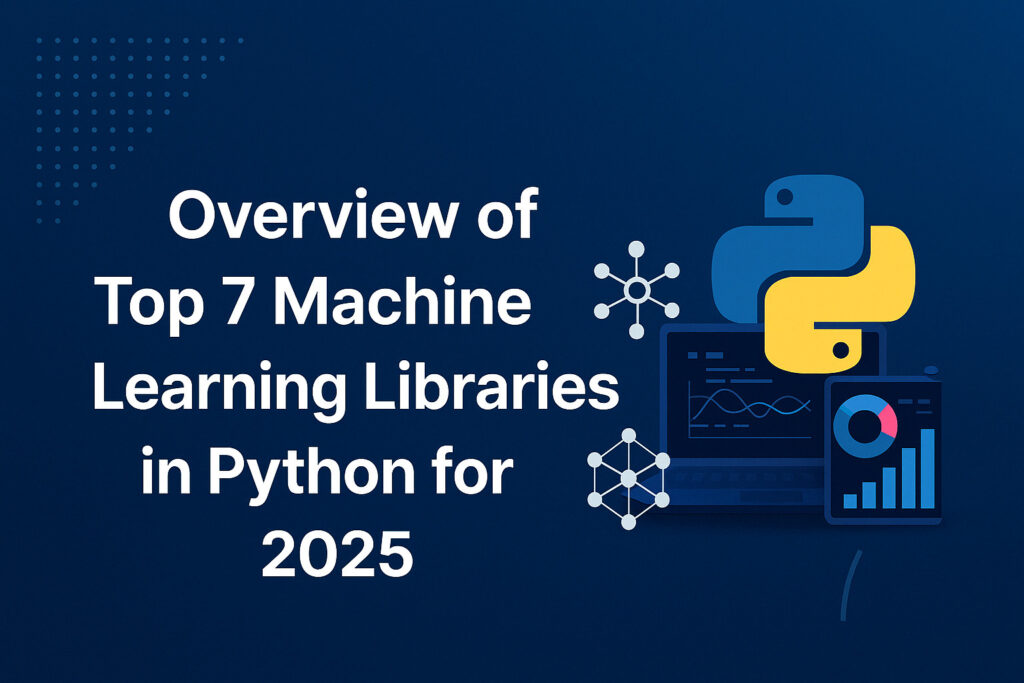Python remains the #1 choice for Machine Learning (ML) developers in 2025, and a big reason is its vast ecosystem of powerful and user-friendly libraries. Whether you’re working on predictive analytics, computer vision, or natural language processing — choosing the right tool can make all the difference.
In this article, we’ll explore the top 7 machine learning libraries that every Python developer should know in 2025.
1️⃣ Scikit-learn – The ML Starter Pack
Perfect for: Beginners & traditional ML algorithms
Scikit-learn is the most trusted library for implementing classical machine learning models. Its clean API, excellent documentation, and tight integration with NumPy and pandas make it the best starting point.
🔹 Use cases: Classification, regression, clustering, dimensionality reduction
🔹 Top Features:
Built-in model evaluation & validation tools
Pipeline creation for streamlined workflows
Simple syntax with powerful capabilities
2️⃣ TensorFlow 2.x + Keras – Deep Learning at Scale
Perfect for: Scalable AI models & production deployment
Backed by Google, TensorFlow is a heavyweight in the deep learning world. With Keras now fully integrated, building neural networks has never been easier or more efficient.
🔹 Use cases: Image recognition, NLP, recommendation engines
🔹 Top Features:
Run models on CPU, GPU, or TPU
TensorBoard for training visualization
TensorFlow Lite & Serving for deployment
3️⃣ PyTorch – The Researcher’s Favorite
Perfect for: Research, experimentation & custom ML models
Originally developed by Facebook (Meta), PyTorch has exploded in popularity due to its dynamic computation graphs and flexibility. It’s now also production-ready with support for mobile and cloud deployment.
🔹 Use cases: Custom DL architectures, AI research, NLP
🔹 Top Features:
Intuitive debugging with eager execution
TorchScript & TorchServe for deployment
Strong integration with Hugging Face, OpenAI models
4️⃣ XGBoost – For Winning Accuracy
Perfect for: Structured/tabular data & competitions
XGBoost (Extreme Gradient Boosting) is a regular winner in data science competitions. It’s efficient, fast, and delivers high accuracy—especially with tabular datasets.
🔹 Use cases: Credit scoring, fraud detection, churn prediction
🔹 Top Features:
Built-in regularization
GPU acceleration for faster training
scikit-learn compatible API
5️⃣ LightGBM – Speed and Efficiency
Perfect for: Large datasets and real-time systems
Created by Microsoft, LightGBM is designed for speed and efficiency. It handles large datasets and supports distributed training out of the box, making it ideal for performance-critical applications.
🔹 Use cases: Real-time ranking, recommendation engines
🔹 Top Features:
Histogram-based learning
Native handling of categorical features
Easy GPU training
6️⃣ Hugging Face Transformers – NLP Made Easy
Perfect for: Natural Language Processing (NLP)
If you’re working with text, look no further than Hugging Face Transformers. It gives you access to thousands of state-of-the-art pre-trained transformer models like BERT, GPT, and RoBERTa.
🔹 Use cases: Chatbots, sentiment analysis, summarization
🔹 Top Features:
One-line access to SOTA models
Compatible with PyTorch, TensorFlow, and JAX
Multi-modal support (text, vision, audio)
7️⃣ CatBoost – ML with Less Preprocessing
Perfect for: Categorical data & business applications
CatBoost, developed by Yandex, shines when working with datasets rich in categorical features. It delivers great accuracy without needing heavy preprocessing or encoding.
🔹 Use cases: Fintech models, sales forecasting
🔹 Top Features:
Native support for categorical variables
Cross-platform GPU/CPU compatibility
Built-in model explainability
Which Library Should You Choose?
| Goal | Recommended Library |
|---|---|
| Classical ML models | Scikit-learn |
| Deep learning (vision/NLP) | TensorFlow or PyTorch |
| Tabular data modeling | XGBoost or LightGBM |
| NLP with transformers | Hugging Face Transformers |
| Handling categorical data easily | CatBoost |

